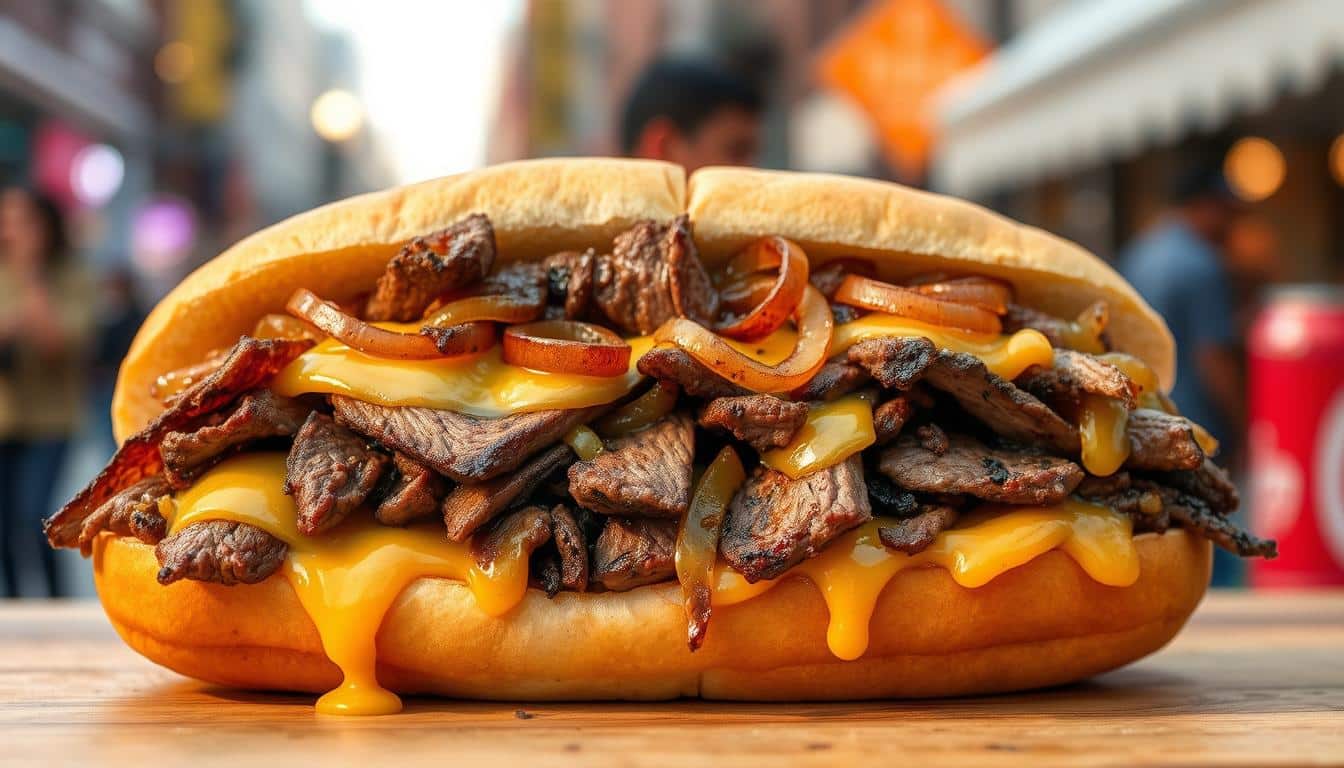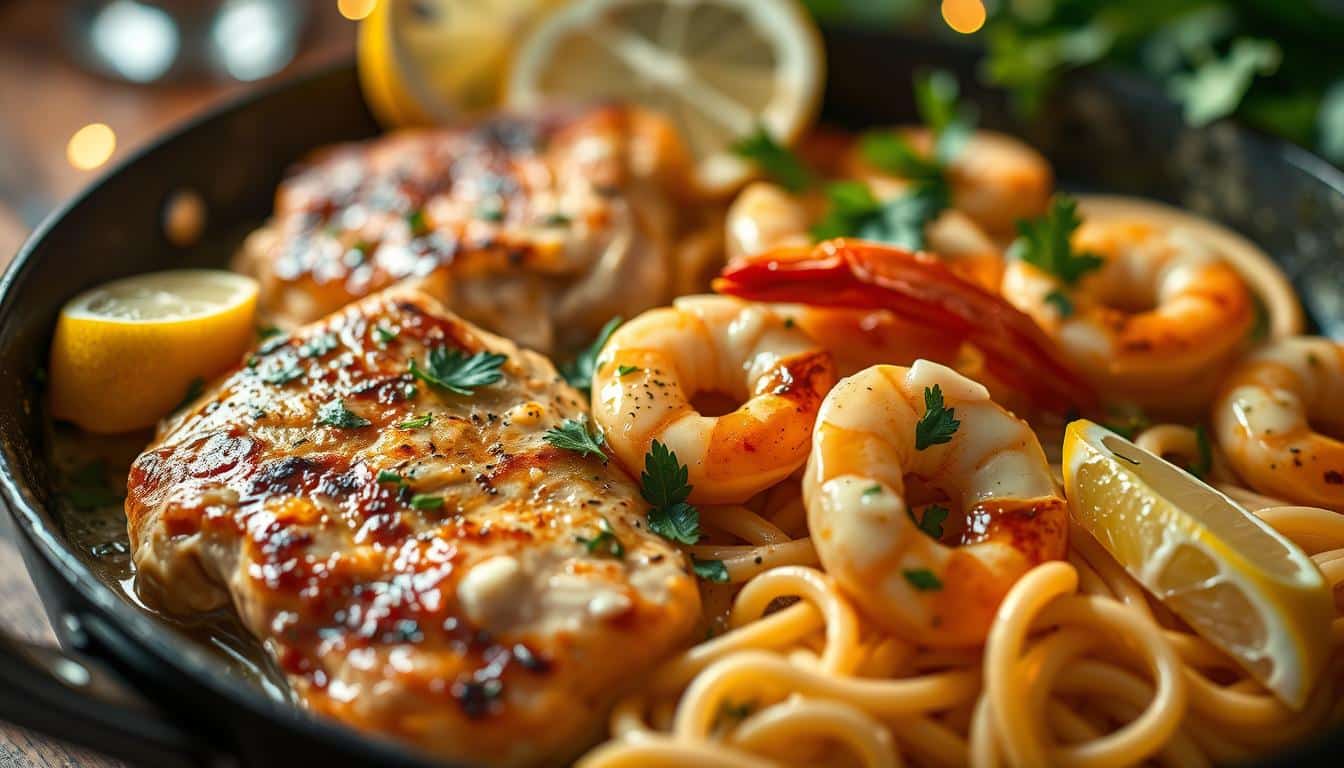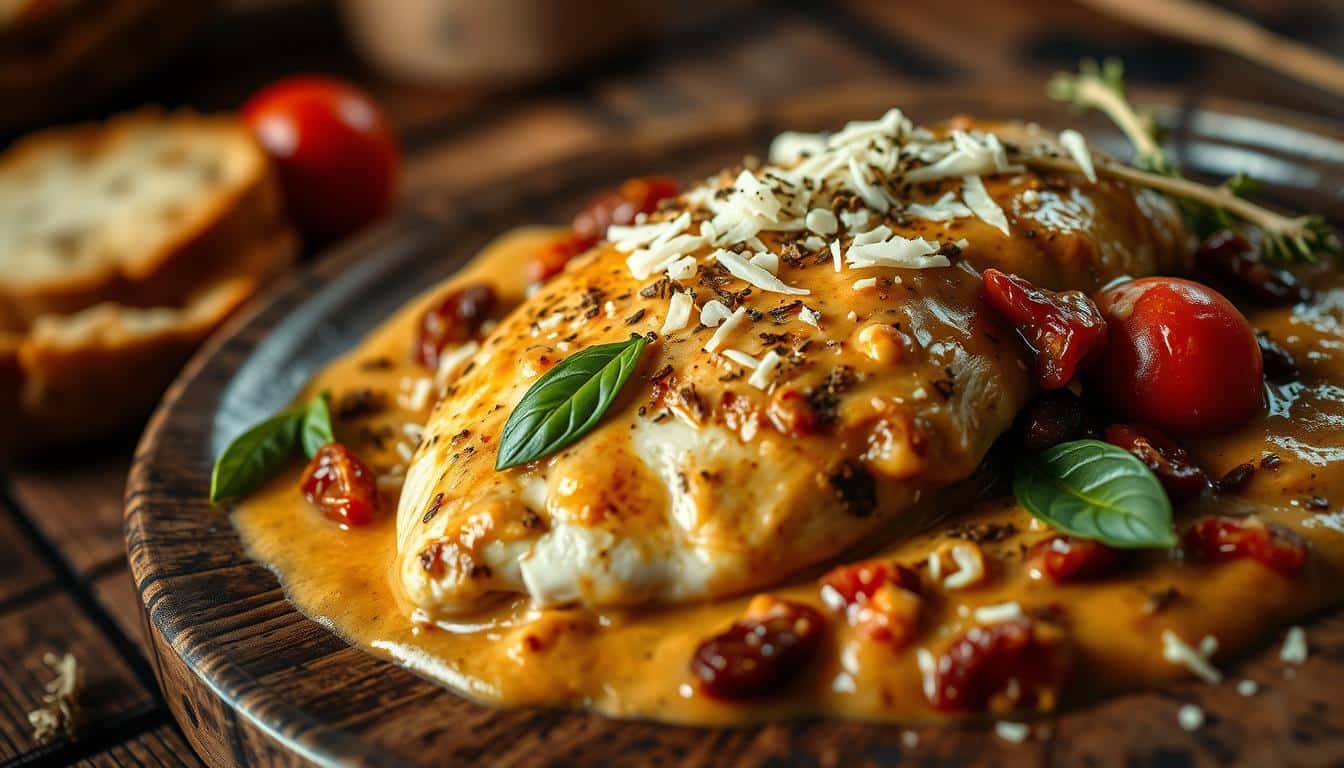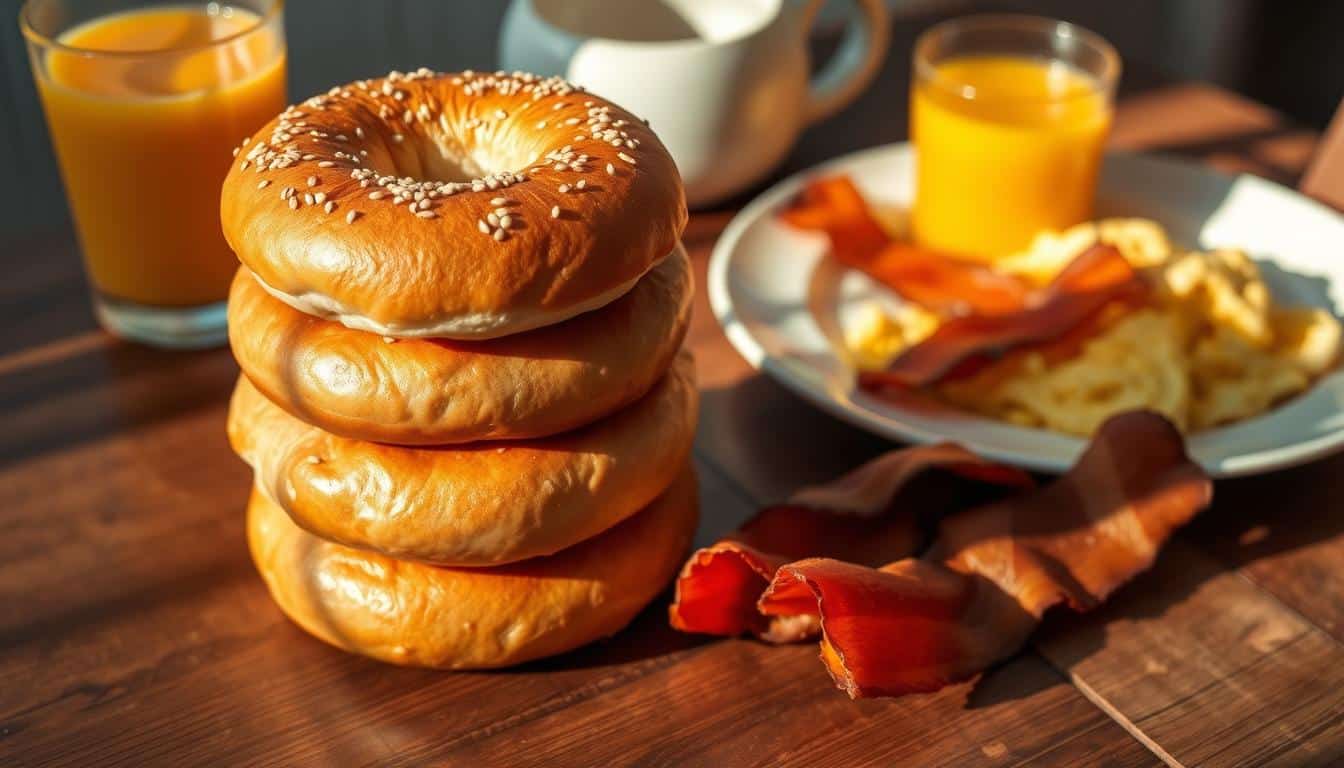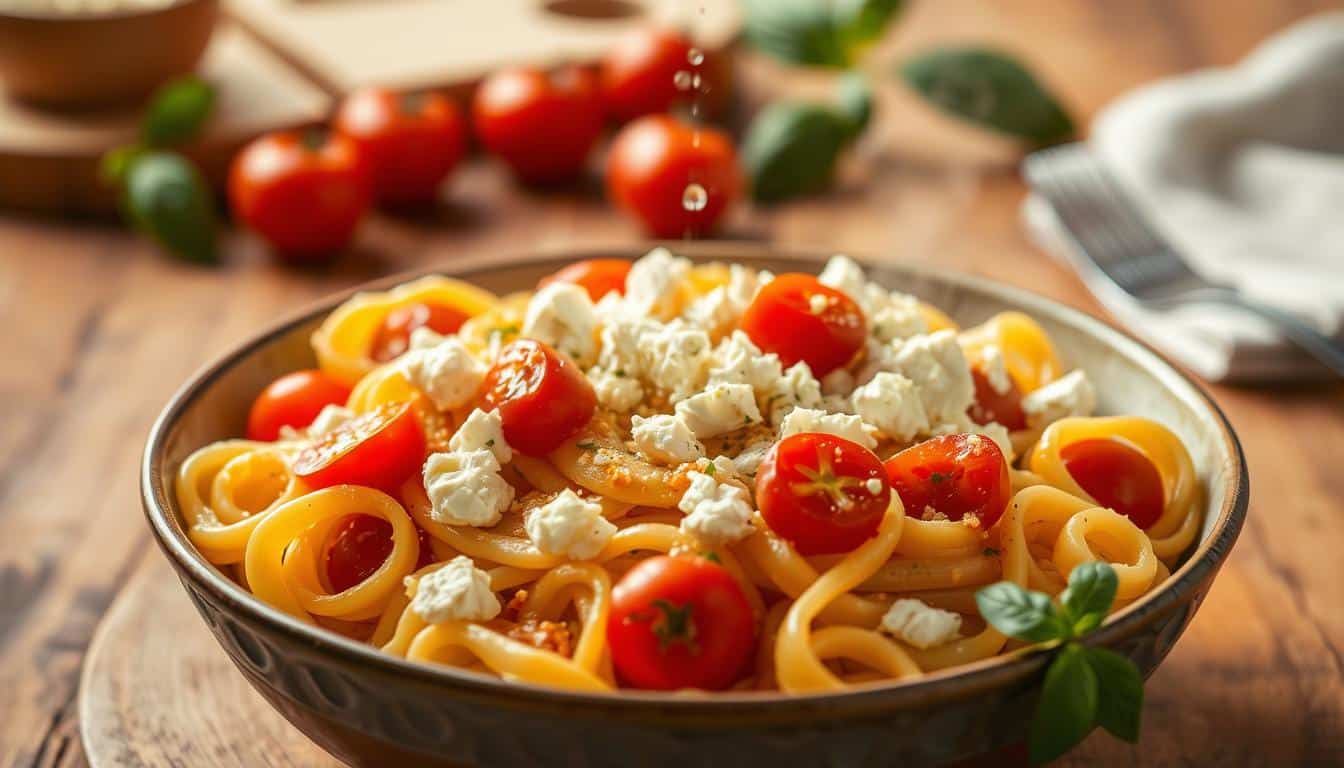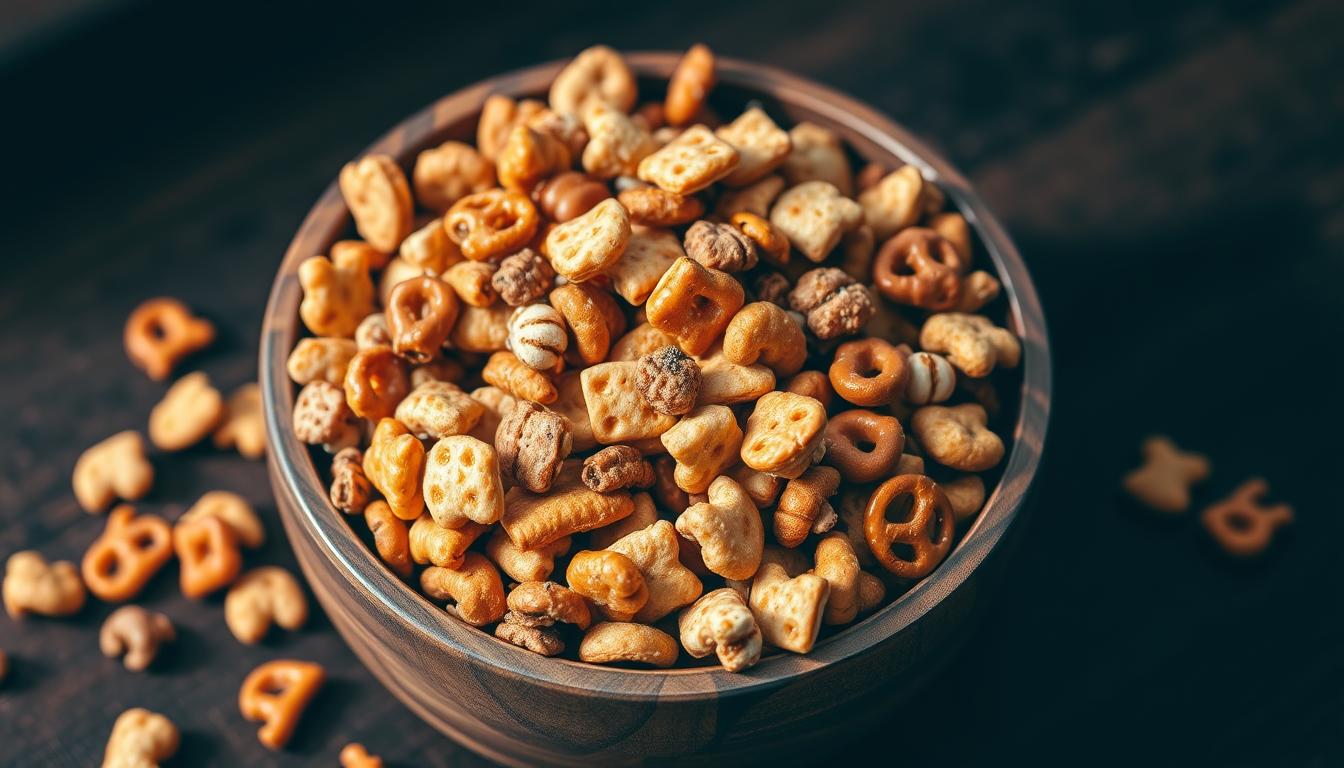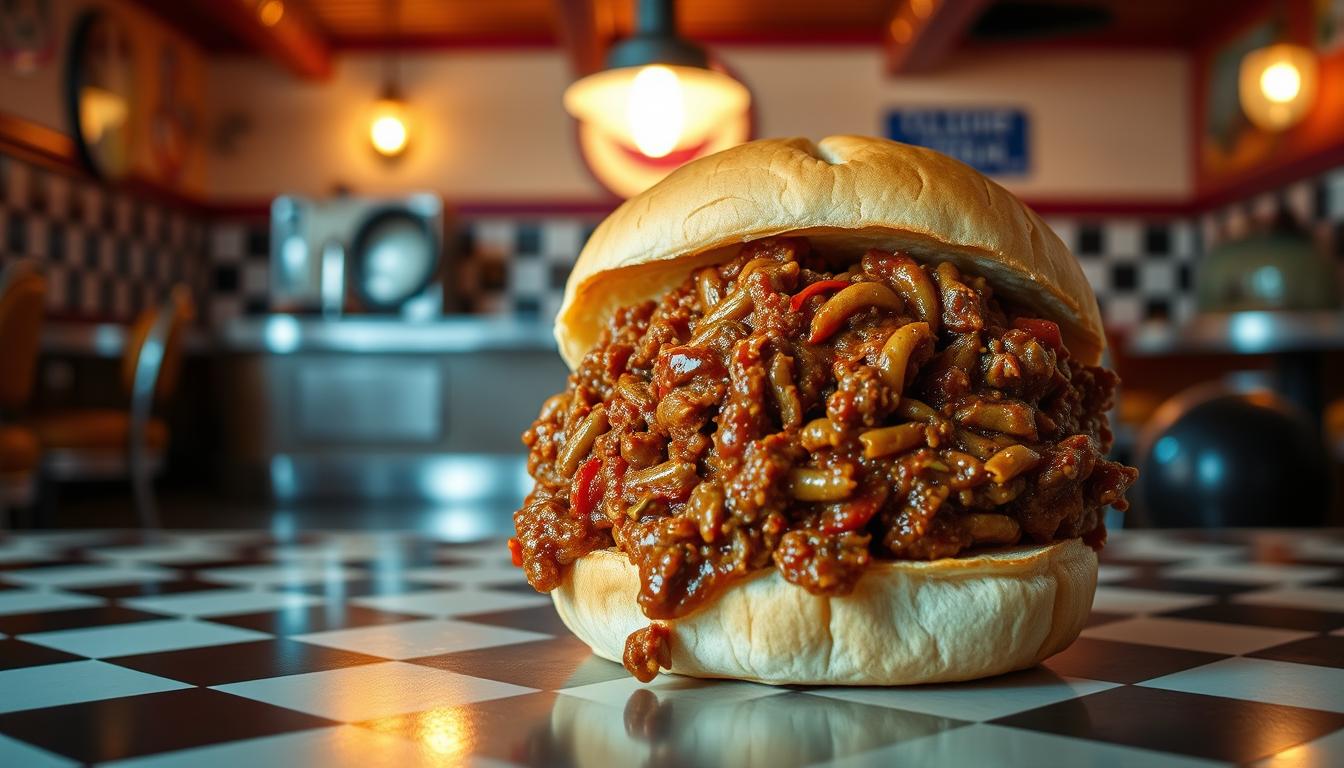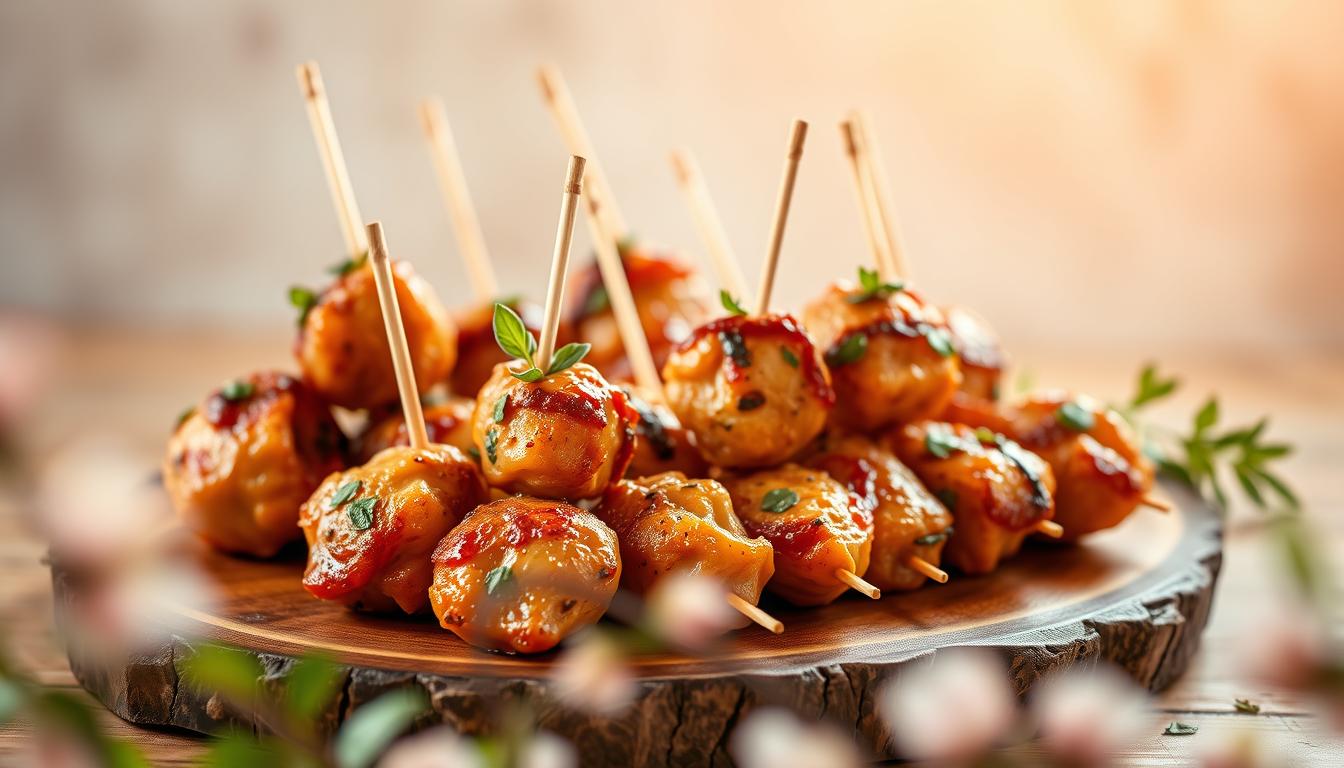Cheesesteak Recipe, Growing up in Pennsylvania, the Philly cheesesteak was more than a sandwich. It was a family tradition that connected us to Philadelphia’s heart. Every bite brought back memories of street vendors, sizzling griddles, and the smell of beef and cheese.
Making an authentic homemade cheesesteak is more than following a recipe. It’s about capturing the soul of Philadelphia’s street food. With the right techniques and ingredients, your kitchen can become a mini Philly sandwich shop.
This guide will show you how to make the perfect Philly cheesesteak. You’ll learn about selecting premium beef and mastering the griddle technique. Whether you love cooking or just love sandwiches, you’ll make a homemade cheesesteak that’s as good as Philadelphia’s best.
Key Takeaways
- Learn the authentic techniques for making a true Philly cheesesteak
- Understand the critical importance of ingredient selection
- Master the griddle cooking method
- Discover regional variations and secret tips
- Create restaurant-quality sandwiches at home
The History Behind Philadelphia’s Iconic Sandwich
The Philly cheesesteak’s story started in the 1930s in Philadelphia. It began as a simple street food and grew into a global favorite. This journey from humble beginnings to worldwide fame is truly fascinating.
Birth of the Philly Cheesesteak
Pat and Harry Olivieri created the cheesesteak by accident. They were trying out beef trimmings at their hot dog stand. A taxi driver smelled the amazing aroma and asked for a sandwich.
This led to the sandwich becoming a hit. It marked the start of a beloved tradition in Philadelphia.
- Invented in the 1930s by Pat and Harry Olivieri
- Originally a simple beef sandwich without cheese
- Quickly gained popularity among local workers
Evolution Through the Decades
Over the years, the Philly cheesesteak became famous across the country. People started adding different cheeses, like Cheez Whiz in the 1950s.
Pat’s vs. Geno’s Legacy
The rivalry between Pat’s King of Steaks and Geno’s Steaks is famous in Philadelphia. These two places are right across from each other in South Philadelphia. They’ve been competing for years.
- Pat’s King of Steaks: Original creators of the cheesesteak
- Geno’s Steaks: Established in 1966
- Both restaurants located in the same intersection
This rivalry has made Philadelphia known as the best place for cheesesteaks. Food enthusiasts from all over come to try this iconic dish.
Essential Ingredients for an Authentic Cheesesteak
Making a real cheesesteak starts with the right ingredients. Each part is key to the Philly taste that makes this sandwich famous.
The main ingredients are simple but important. You need top-notch beef, like ribeye or top round, cut very thin. The meat should be fresh and sliced against the grain for tenderness.
- Beef Cut: Ribeye or top round, sliced paper-thin
- Cheese Options: Provolone, American, or Cheez Whiz
- Bread: Long, crusty Philadelphia-style roll
- Onions: White or yellow, thinly sliced
Your cheesesteak recipe needs to be precise. The roll should be soft inside but a bit crunchy outside. Amoroso rolls are best, but any sturdy hoagie roll works too.
Choosing the right cheese is key. Cheez Whiz is a classic, but provolone and American cheese melt well over the meat.
You can add toppings like bell peppers or mushrooms to make it your own. But, the true cheesesteak fans stick to onions and cheese.
Selecting the Perfect Cut of Beef
Making a real cheesesteak begins with picking the right beef. The meat is the main attraction in this classic Philly sandwich. Choosing the right cut is key to a great sandwich.
For a true cheesesteak, always go with ribeye. It has the perfect mix of taste and softness. The marbling in ribeye makes the meat juicy and full of flavor.
Top Beef Cuts for Cheesesteaks
- Ribeye: The gold standard for cheesesteaks
- Top sirloin: A leaner alternative
- Striploin: Good for budget-conscious cooks
Mastering Slicing Techniques
Slicing steak for a cheesesteak needs care. Cut against the grain for thin strips that cook fast and stay soft. Freezing the meat for 15-20 minutes helps with slicing.
| Beef Cut | Ideal Thickness | Recommended Cooking Method |
|---|---|---|
| Ribeye | 1/8 inch | High-heat griddle |
| Top Sirloin | 1/4 inch | Flat-top grill |
Temperature Guidelines
Keeping the meat at the right temperature is key. Make sure your beef is around 40°F before slicing. Cook on a very hot griddle or pan, about 400-450°F, for that crispy outside.
- Pre-slicing temperature: 35-40°F
- Cooking surface temperature: 400-450°F
- Desired meat temperature: Medium-rare to medium
Choosing the Right Cheese Options
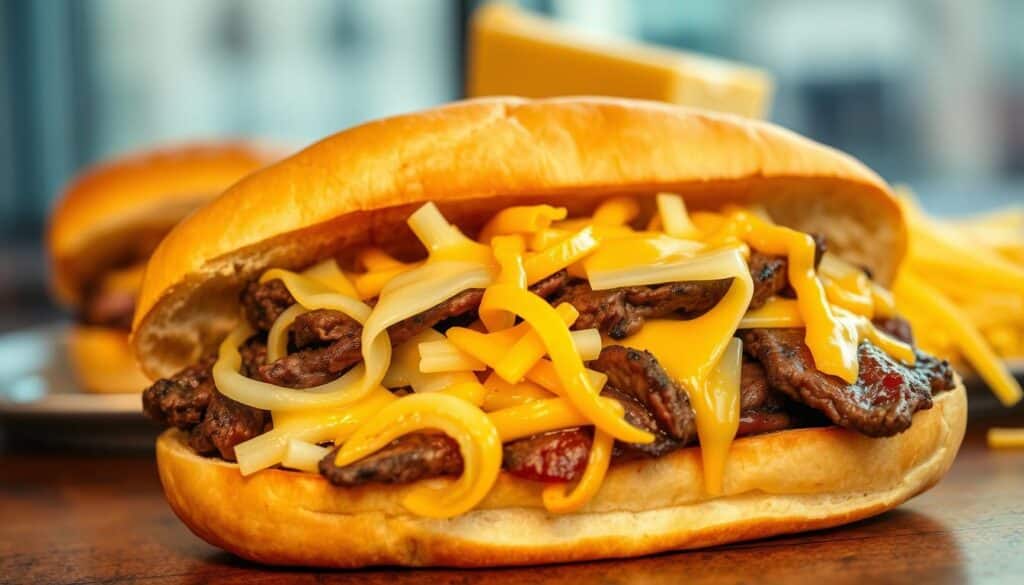
Choosing the right cheese for your cheesesteak is key. It’s not just a topping; it’s what makes the sandwich special. The cheese brings the authentic Philadelphia taste to life.
The classic debate is between three main cheeses:
- Cheez Whiz: The go-to for many Philadelphia fans
- Provolone: Known for its smooth melting and rich taste
- American cheese: A creamy mix of the two
The battle between Cheez Whiz and provolone is a big deal for cheesesteak lovers. Cheez Whiz has a tangy, processed taste that many adore. Its bright yellow color and unique flavor bring back memories of Philly street food.
Provolone, on the other hand, offers a more complex flavor. It melts well and adds a nutty taste that pairs well with beef. Some say provolone makes the cheesesteak even better.
Your choice of cheese depends on what you like. If you’re a traditionalist, Cheez Whiz might be your pick. But if you prefer a more refined taste, provolone is the way to go. Feel free to try different cheeses to find your favorite!
The Perfect Roll: Making or Buying
The roll is key to a real Philadelphia cheesesteak. The right roll can make your sandwich amazing. It should balance texture and flavor with the meat and cheese.
Amoroso rolls are the top choice for Philly cheesesteaks. They have a soft inside and a crisp outside. This makes them perfect for holding steak and cheese.
Traditional Amoroso Rolls: The Authentic Choice
Amoroso rolls are the best for cheesesteaks. Bakers in Philadelphia have made these rolls for years. They have a soft inside, a crisp outside, and are just the right length.
- Soft, pillowy interior
- Slightly crusty exterior
- Perfect length for holding generous portions of steak
- Mild wheat flavor that complements the filling
Homemade Roll Alternatives
Can’t find Amoroso rolls? No worries. You can use local bakery rolls or make your own. Look for rolls that are long, soft, and sturdy.
- Long, soft hoagie-style rolls
- Sturdy enough to hold heavy fillings
- Slightly chewy texture
- Fresh baked if possible
Proper Roll Preparation
Preparing your roll can make your cheesesteak even better. Try these tips to improve your roll:
| Preparation Method | Technique | Result |
|---|---|---|
| Lightly Toasting | Warm roll on griddle for 30 seconds | Crisp exterior, soft interior |
| Steaming | Quick steam before filling | Extra softness, enhanced flavor |
| Butter Brushing | Light butter application before toasting | Rich, golden-brown finish |
The right roll makes a simple sandwich into a masterpiece. Use Amoroso rolls or make your own. The key is to prepare it well for the best cheesesteak.
Cheesesteak Recipe: Step-by-Step Instructions
Making a cheesesteak is all about precision and passion. This guide will help you make a perfect Philly-style sandwich at home.
To start, you need the right ingredients. You’ll need thinly sliced ribeye steak, fresh rolls, and your favorite cheese.
- Prepare the Meat: Freeze the ribeye for 30 minutes to make slicing easier. Cut it into thin strips against the grain.
- Slice Vegetables: Chop onions thinly for a traditional flavor and caramelization.
- Heat the Griddle: Use a flat surface at medium-high heat for the best cooking.
When cooking, technique is key. Spread the meat thinly on the griddle. This way, it browns quickly without getting overcooked.
| Ingredient | Quantity | Preparation |
|---|---|---|
| Ribeye Steak | 1 pound | Thinly sliced |
| Onions | 1 medium | Chopped |
| Cheese | 4 slices | Provolone or Cheez Whiz |
| Rolls | 2-3 | Soft hoagie style |
The last step is to assemble the sandwich. Place meat, cheese, and onions in a warm roll. Serve it right away for the best taste and texture.
Mastering the Griddle Technique
Cooking cheesesteak needs precision and skill, especially with griddle techniques. The right method can turn simple ingredients into a delicious Philadelphia classic. Knowing how to control your griddle is key to making the perfect cheesesteak.
Professional chefs see griddle cooking as an art. Your griddle should be hot but not too hot. This lets the meat cook fast and get a tasty caramelized outside.
Temperature Control Tips
Griddle temperature is very important for cooking cheesesteak. You should keep the heat between 350-400°F. Here are some tips:
- Preheat the griddle for at least 10 minutes
- Use an infrared thermometer for precise temperature tracking
- Avoid overcrowding the cooking surface
- Keep a spray bottle nearby to manage heat and prevent burning
Proper Flipping Methods
Your griddle techniques affect the meat’s texture and taste. Use a wide, flat spatula to flip thin slices of beef fast. Rapid, confident movements help prevent sticking and ensure even cooking.
Timing Your Cook
Timing is crucial when making a cheesesteak. Thinly sliced beef cooks in 1-2 minutes. Look for a light brown color and avoid overcooking, which can make the meat tough.
Professional griddle masters suggest practicing to get better at making cheesesteaks.
Classic Toppings and Variations
The magic of a great cheesesteak is in its flexibility. Traditional toppings are still loved, but new twists have made the sandwich exciting again. Modern chefs have added their own flavors, making this classic sandwich even better.
Classic cheesesteak toppings include:
- Sautéed onions
- Bell peppers
- Mushrooms
- Hot peppers
Regional variations bring new flavors to the classic recipe. While some might say these changes stray from the original, they add delicious twists. They honor the sandwich’s roots while introducing new tastes.
Some popular variations are:
- Philly Pizza Cheesesteak: Adds marinara sauce and mozzarella
- Ranch Cheesesteak: Includes creamy ranch dressing
- Buffalo Chicken Cheesesteak: Uses spicy chicken instead of beef
- Vegetarian Cheesesteak: Uses portobello mushrooms or plant-based protein
When trying new toppings, remember to keep it balanced. You want to add to the flavor without overpowering the beef and cheese. This way, you get the best of both worlds.
Common Mistakes to Avoid
Making the perfect cheesesteak takes skill and focus. Knowing common mistakes can make your sandwich better. Start by avoiding cooking problems.
Every home cook faces challenges making this famous Philadelphia sandwich. Knowing what to avoid can improve your cooking. It can make your sandwich taste like it’s from a restaurant.
Temperature Errors to Avoid
Keeping the right temperature is key for a tasty cheesesteak. Here are mistakes to avoid:
- Cooking meat too hot, making it tough
- Not heating the griddle or skillet enough
- Overcooking thin beef, making it dry
Ingredient Selection Mishaps
Choosing the right ingredients is crucial. Watch out for these common mistakes:
- Using bad or wrong beef cuts
- Picking cheese that doesn’t melt well
- Choosing bread that’s too soft or too hard
Assembly Challenges
Assembling your cheesesteak needs care. Avoid these common problems:
| Problem | Solution |
|---|---|
| Soggy bread | Toast the roll lightly before adding ingredients |
| Uneven meat distribution | Spread the meat evenly on the roll |
| Cold cheese | Add cheese when the meat is hot to melt it |
By knowing these mistakes and using the right fixes, you’ll make a delicious sandwich. It will be as good as Philadelphia’s best.
Serving and Presentation Tips
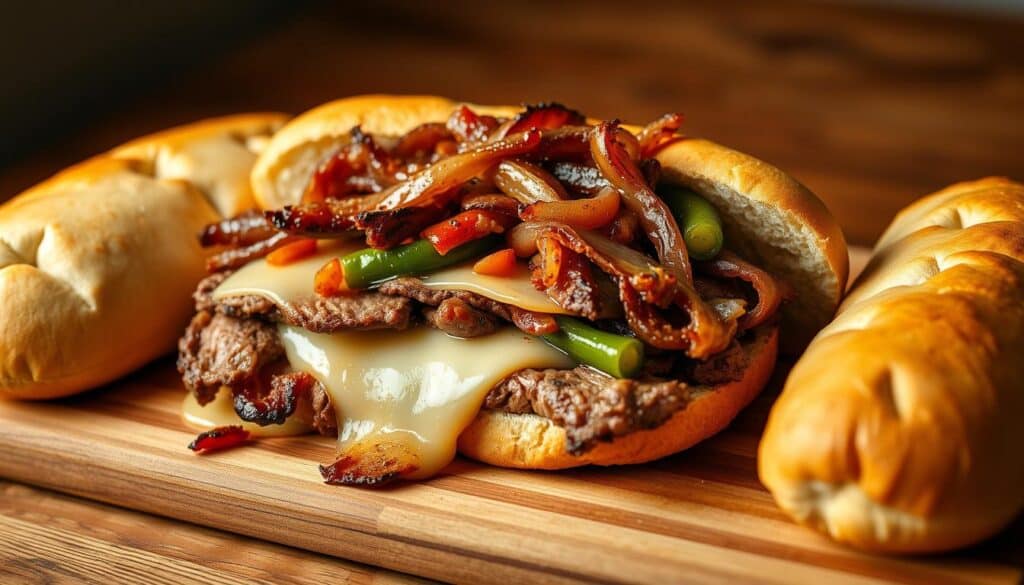
Learning how to serve a cheesesteak is more than just cooking the meat. The right way to present it can make your sandwich amazing. You want to bring a taste of Philadelphia into your kitchen.
Here are some key tips for serving your cheesesteak:
- Wrap the sandwich tightly in white butcher paper or aluminum foil to keep it hot and in shape
- Serve it right away to get the best taste and texture
- Cut the sandwich diagonally to show off the melted cheese and juicy meat inside
Presenting your cheesesteak is not just about putting it on a plate. Make it look good by:
- Using a rustic wooden cutting board as a serving platform
- Adding a small side of pickled peppers or hot sauce
- Pairing it with crispy potato chips or hand-cut fries
For a true Philadelphia touch, serve it on classic white paper or a simple plate. True Philadelphia style is simple. Let the sandwich’s rich flavors shine.
Pro tip: Have extra napkins ready. A great cheesesteak is messy, and that’s what makes it special!
Storage and Reheating Guidelines
Keeping your homemade cheesesteak tasty means storing and reheating it right. The right storage keeps the sandwich fresh and safe to eat.
Here’s how to store your cheesesteak:
- Wrap the sandwich tightly in aluminum foil or plastic wrap
- Place in an airtight container
- Refrigerate within 2 hours of making it
- Eat it within 3-4 days for the best taste
Reheating your cheesesteak needs care to keep its flavor and texture. You can use a few methods:
- Oven Method:
- Preheat to 350°F
- Wrap sandwich in foil
- Heat for 10-15 minutes
- This keeps the bread from getting soggy
- Skillet Method:
- Use medium-low heat
- Cover with lid to keep moisture in
- Heat for 3-5 minutes
- This makes the outside crispy again
- Microwave Method:
- Use 50% power
- Heat in 30-second bursts
- Watch to avoid overheating
- It’s quick but might not be as good
Tip: Don’t reheat your cheesesteak too many times. It can make the meat tough and taste bad. Always reheat only what you’re going to eat right away.
Conclusion
Mastering the authentic cheesesteak recipe takes passion and practice. Your journey starts with understanding the essential techniques and ingredients. From selecting premium beef to choosing the right cheese and roll, each step is crucial.
The homemade Philly cheesesteak is more than a meal. It connects you to Philadelphia’s rich food heritage. Your commitment to quality ingredients and careful preparation will make your sandwich stand out. Remember, every great chef began as a beginner.
Now, you’re ready to experiment and develop your unique cheesesteak style. Practice griddle techniques, try different cheeses, and trust your instincts. Your kitchen can become the ultimate place for an authentic Philadelphia sandwich experience.
Start your cheesesteak adventure today. Share your creations with friends and family. Don’t hesitate to refine your technique with each attempt. Your passion for great food will shine through in every delicious bite.
